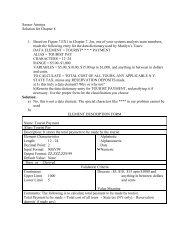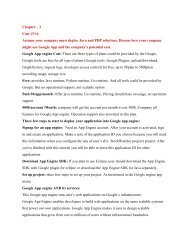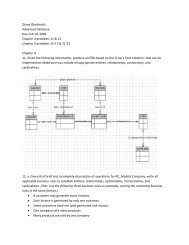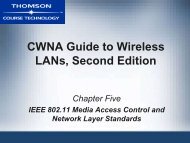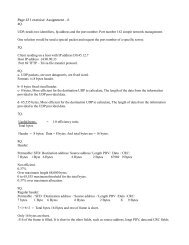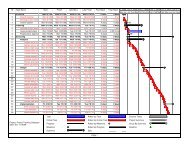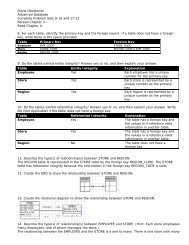Underlying Technologies ppt - Csmaster
Underlying Technologies ppt - Csmaster
Underlying Technologies ppt - Csmaster
- No tags were found...
Create successful ePaper yourself
Turn your PDF publications into a flip-book with our unique Google optimized e-Paper software.
Chapter 3<strong>Underlying</strong>TechnologyTCP/IP Protocol Suite 1Copyright © The McGraw-Hill Companies, Inc. Permission required for reproduction or display.
OBJECTIVES: To briefly discuss the technology of dominant wired LANs,Ethernet, including traditional, fast, gigabit, and ten-gigabitEthernet. To briefly discuss the technology of wireless WANs, includingIEEE 802.11 LANs, and Bluetooth. To briefly discuss the technology of point-to-point WANsincluding 56K modems, DSL, cable modem, T-lines, and SONET. To briefly discuss the technology of switched WANs includingX.25, Frame Relay, and ATM. To discuss the need and use of connecting devices such asrepeaters (hubs), bridges (two-layer switches), and routers(three-layer switches).TCP/IP Protocol Suite 2
ChapterOutline3.1 Wired Local Area Network3.2 Wireless LANs3.3 Point-to-Point WANs3.4 Switched WANs3.5 Connecting DevicesTCP/IP Protocol Suite 3
3-1 WIRED LOCAL AREA NETWORKSA local area network (LAN) is a computer network that isdesigned for a limited geographic area such as abuilding or a campus. Although a LAN can be used asan isolated network to connect computers in anorganization for the sole purpose of sharing resources,most LANs today are also linked to a wide area network(WAN) or the Internet.The LAN market has seen several technologiessuch as Ethernet, token ring, token bus, FDDI, and ATMLAN, but Ethernet is by far the dominant technology.TCP/IP Protocol Suite 4
Topics Discussed in the SectionIEEE StandardsFrame FormatAddressingEthernet EvolutionStandard EthernetFast EthernetGigabit EthernetTen-Gigabit EthernetTCP/IP Protocol Suite 5
Figure 3.1 IEEE standard for LANsTCP/IP Protocol Suite 6
Figure 3.2 Ethernet FrameTCP/IP Protocol Suite 7
Figure 3.3 Maximum and minimum lengthsTCP/IP Protocol Suite 8
NoteThe least significant bit of the first bytedefines the type of address.If the bit is 0, the address is unicast;otherwise, it is multicast.TCP/IP Protocol Suite 13
Figure 3.6 Ethernet evolution through four generationsTCP/IP Protocol Suite 16
Figure 3.7 Space/time model of a collision in CSMAB startsat time t 1C startsat time t 2A BC DArea whereA’s signal existsArea whereboth signals existArea whereB’s signal existsT i m eT i m eTCP/IP Protocol Suite 17
Figure 3.8 Collision of the first bit in CSMA/CDTCP/IP Protocol Suite 18
Example 3.3In the standard Ethernet, if the maximum propagation time is25.6 μs, what is the minimum size of the frame?SolutionThe frame transmission time is T fr = 2 × T p = 51.2 μs. Thismeans, in the worst case, a station needs to transmit for aperiod of 51.2 μs to detect the collision. The minimum size ofthe frame is 10 Mbps × 51.2 μs = 512 bits or 64 bytes. This isactually the minimum size of the frame for Standard Ethernet,as we discussed before.TCP/IP Protocol Suite 19
Figure 3.9 CSMA/CD flow diagramTCP/IP Protocol Suite 20
TCP/IP Protocol Suite 21
Figure 3.10 Standard Ethernet implementationTCP/IP Protocol Suite 22
TCP/IP Protocol Suite 23
Figure 3.11 Fast Ethernet implementationTCP/IP Protocol Suite 24
TCP/IP Protocol Suite 25
NoteIn the full-duplex mode of GigabitEthernet, there is no collision;the maximum length of the cable isdetermined by the signal attenuationin the cable.TCP/IP Protocol Suite 26
Figure 3.12 Gigabit Ethernet implementationTCP/IP Protocol Suite 27
TCP/IP Protocol Suite 28
3-2 WIRELESS LANSWireless communication is one of the fastestgrowing technologies. The demand for connectingdevices without the use of cables is increasingeverywhere. Wireless LANs can be found on collegecampuses, in office buildings, and in many publicareas. In this section, we concentrate on twowireless technologies for LANs: IEEE 802.11wireless LANs, sometimes called wireless Ethernet,and Bluetooth, a technology for small wireless LANs.TCP/IP Protocol Suite 29
Topics Discussed in the SectionIEEE 802.1MAC SublayerAddressing MechanismBluetoothTCP/IP Protocol Suite 30
Figure 3.13 Basic service sets (BSSs)TCP/IP Protocol Suite 31
Figure 3.14 Extended service sets (ESSs)TCP/IP Protocol Suite 32
Figure 3.15 CSMA/CA flow diagramTCP/IP Protocol Suite 33
Figure 3.16 CSMA/CA and NAVSourceDestinationAll other stations• • •DIFSSIFS31RTSCTS 2DataSIFSNAV(No carrier sensing)ACK 4SIFSTime TimeTime TimeTCP/IP Protocol Suite 34
Figure 3.17 Frame formatTCP/IP Protocol Suite 35
TCP/IP Protocol Suite 36
Figure 3.18 Control framesTCP/IP Protocol Suite 37
TCP/IP Protocol Suite 38
TCP/IP Protocol Suite 39
Figure 3.19 Hidden station problemTCP/IP Protocol Suite 40
NoteThe CTS frame in CSMA/CA handshakecan prevent collision from a hiddenstation.TCP/IP Protocol Suite 41
Figure 3.20 Use of handshaking to prevent hidden station problemBACRTSCTSCTSTime Time TimeTCP/IP Protocol Suite 42
Figure 3.21 Exposed station problemTCP/IP Protocol Suite 43
Figure 3.22 Use of handshaking in exposed station problemRTSCTSDataRTSRTSDataRTSCTSCollisionhereTCP/IP Protocol Suite 44
Figure 3.23 PiconetTCP/IP Protocol Suite 45
Figure 3.24 ScatternetTCP/IP Protocol Suite 46
Figure 3.25 Frame format types72 bits 54 bits 0 to N bitsAccess code Header DataTCP/IP Protocol Suite 47
3-3 POINT-TO-POINT WANSA second type of network we encounter in theInternet is the point-to-point wide area network. Apoint-to-point WAN connects two remote devicesusing a line available from a public network such asa telephone network. We discuss traditional modemtechnology, DSL line, cable modem, T-lines, andSONET.TCP/IP Protocol Suite 48
Topics Discussed in the Section65K ModemsDSL TechnologyCable ModemT Lines SONETPPPTCP/IP Protocol Suite 49
Figure 3.26 56K modemUploading,quantization noiseDownloading,no quantization noiseTCP/IP Protocol Suite 50
NoteADSL is an asymmetric communicationtechnology designed for residentialusers; it is not suitable for businesses.TCP/IP Protocol Suite 51
Figure 3.27 Bandwidth divisionTCP/IP Protocol Suite 52
Figure 3.28 ADSL and DSLAMTCP/IP Protocol Suite 53
Figure 3.29 Cable bandwidthTCP/IP Protocol Suite 54
Figure 3.30 Cable modem configurationTCP/IP Protocol Suite 55
TCP/IP Protocol Suite 56
TCP/IP Protocol Suite 57
Figure 3.31 PPP frameTCP/IP Protocol Suite 58
3-4 SWITCHED WANSThe backbone networks in the Internet can beswitched WANs. A switched WAN is a wide areanetwork that covers a large area (a state or acountry) and provides access at several points to theusers. Inside the network, there is a mesh of pointto-pointnetworks that connects switches. Theswitches, multiple port connectors, allow theconnection of several inputs and outputs.Switched WAN technology differs from LANtechnology in many ways.TCP/IP Protocol Suite 59
Topics Discussed in the SectionX.25Frame RelayATMTCP/IP Protocol Suite 60
NoteA cell network uses the cell as the basicunit of data exchange.A cell is defined as a small, fixed-sizeblock of information.TCP/IP Protocol Suite 61
Figure 3.32 ATM multiplexingA3A2A1B2B1C3B2A3C2B1A2C1A1C3C2C1TCP/IP Protocol Suite 62
Figure 3.33 Architecture of an ATM networkTCP/IP Protocol Suite 63
Figure 3.34 Virtual circuitTCP/IP Protocol Suite 64
NoteA virtual connection is defined by a pairof numbers: the VPI and the VCI.TCP/IP Protocol Suite 65
Figure 3.35 ATM layersTCP/IP Protocol Suite 66
Figure 3.36 Use of the layersTCP/IP Protocol Suite 67
NoteThe IP protocol uses the AAL5 sublayer.TCP/IP Protocol Suite 68
Figure 3.37 AAL5TCP/IP Protocol Suite 69
Figure 3.38 ATM layerTCP/IP Protocol Suite 70
Figure 3.39 An ATM cellTCP/IP Protocol Suite 71
3-5 CONNECTING DEVICESLANs or WANs do not normally operate in isolation.They are connected to one another or to theInternet. To connect LANs and WANs together weuse connecting devices. Connecting devices canoperate in different layers of the Internet model. Wediscuss three kinds of connecting devices: repeaters(or hubs), bridges (or two-layer switches), androuters (or three-layer switches).TCP/IP Protocol Suite 72
Topics Discussed in the SectionRepeatersBridgesRoutersTCP/IP Protocol Suite 73
Figure 3.40 Connecting devicesTCP/IP Protocol Suite 74
Figure 3.41 Repeater or hubSentMaintainedTCP/IP Protocol Suite 75
NoteA repeater forwards every bit; it has nofiltering capability.TCP/IP Protocol Suite 76
NoteA bridge has a table used in filteringdecisions.TCP/IP Protocol Suite 77
NoteA bridge does not change the physical(MAC) addresses in a frame.TCP/IP Protocol Suite 78
Figure 3.42 BridgeBridge tableAddress Port71:2B:13:45:61:41 171:2B:13:45:61:42 264:2B:13:45:61:12 364:2B:13:45:61:13 4TCP/IP Protocol Suite 79
Figure 3.43 Learning bridgeAddressa. OriginalPortAddress Port71:2B:13:45:61:41 164:2B:13:45:61:13 4c. After D sends a frame to BAddress Port71:2B:13:45:61:41 164:2B:13:45:61:13 471:2B:13:45:61:42 2d. After B sends a frame to AAddress Port71:2B:13:45:61:41 164:2B:13:45:61:1371:2B:13:45:61:424264:2B:13:45:61:12 3e. After C sends a frame to DMMMMTCP/IP Protocol Suite 80
NoteA router is a three-layer (physical, datalink, and network) device.TCP/IP Protocol Suite 81
NoteA repeater or a bridge connectssegments of a LAN.A router connects independent LANs orWANs to create an internetwork(internet).TCP/IP Protocol Suite 82
Figure 3.44 Routing exampleTCP/IP Protocol Suite 83
NoteA router changes the physicaladdresses in a packet.TCP/IP Protocol Suite 84



